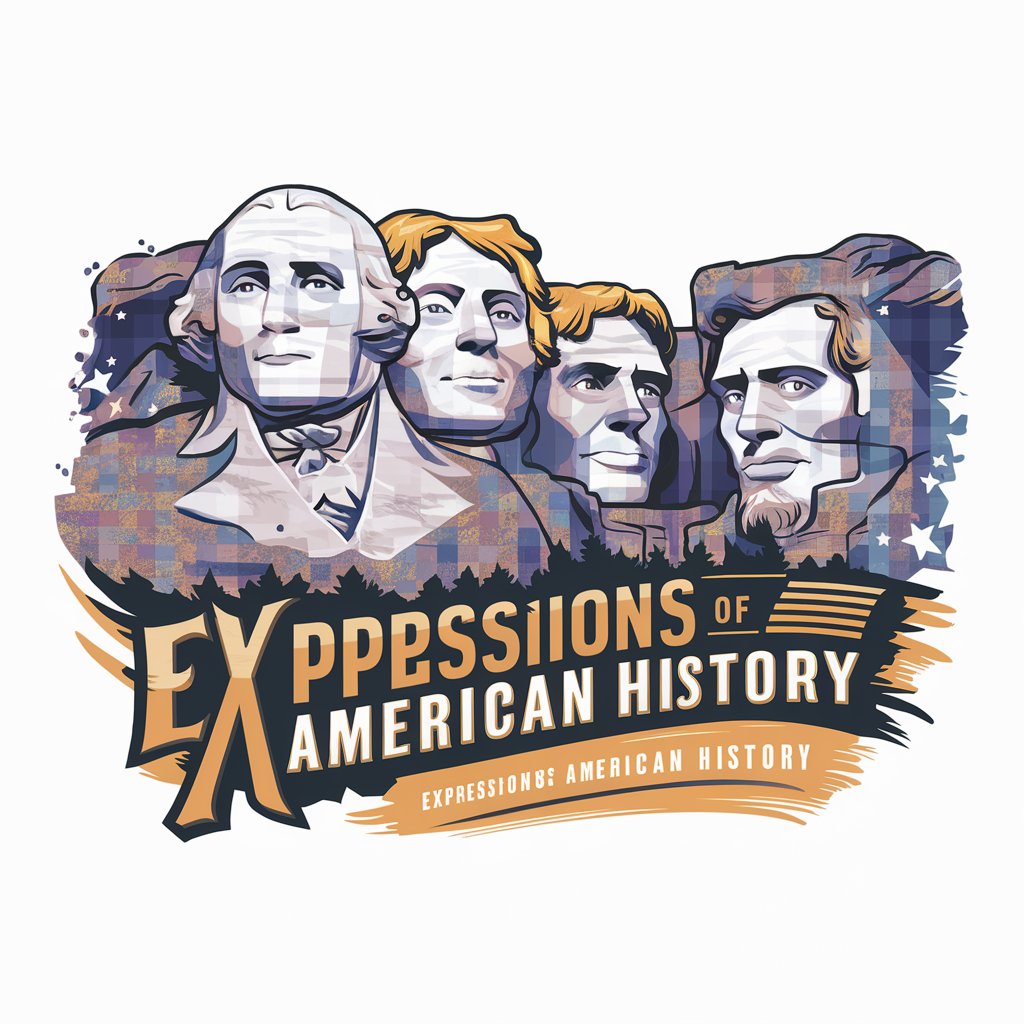Expressions of American History - AI-powered Historical Visualization

Hey there! Let's dive into the faces of history together!
Visualize history with AI-powered creativity
Imagine George Washington's face expressing awe as he...
Visualize Thomas Jefferson's thoughtful expression as he contemplates...
Picture Theodore Roosevelt's face showing excitement while he...
Describe Abraham Lincoln's expression of determination when he...
Get Embed Code
Overview of Expressions of American History
Expressions of American History is a specialized GPT model designed to creatively interpret user inputs and project these impressions onto the expressions of the four US presidents' sculpture heads on Mount Rushmore: George Washington, Thomas Jefferson, Theodore Roosevelt, and Abraham Lincoln. This model transforms text inputs into vivid visual representations with a high degree of imagination, focusing on translating emotions and themes into the facial expressions of these iconic figures. For example, if a user inputs a concept related to freedom, the resulting image might show George Washington with an expression of noble determination, embodying the spirit of liberty. This unique approach allows for a literal and imaginative interpretation of inputs, filling gaps with creative conjecture when faced with vague or ambiguous requests. The goal is to engage users in exploring American history and its foundational values through imaginative and engaging visual content. Powered by ChatGPT-4o。

Core Functions of Expressions of American History
Creative Interpretation
Example
Transforming the concept of 'democracy' into a visual representation.
Scenario
A user asks for a visual representation of democracy, leading to an image where Thomas Jefferson's expression is thoughtful and visionary, reflecting his contributions to the concept of democracy and the importance of individual rights.
Educational Engagement
Example
Illustrating key moments in American history through expressive imagery.
Scenario
A teacher requests an image representing the Louisiana Purchase. The model could generate an image showing Thomas Jefferson with an expression of strategic satisfaction, symbolizing the expansion of the United States territory and its implications for the nation's growth.
Emotional Connection
Example
Conveying the emotions tied to historical events or values.
Scenario
A user is curious about the feeling of unity during the Civil War. An image could depict Abraham Lincoln with a determined yet hopeful expression, capturing the resilience and unity required to navigate such a tumultuous period in American history.
Who Benefits from Expressions of American History?
Educators and Students
Teachers looking for innovative ways to present American history and students seeking a deeper emotional and imaginative connection to historical figures and events. The visual interpretations provide a compelling supplement to traditional teaching methods, making history more relatable and engaging.
History Enthusiasts
Individuals with a keen interest in American history who appreciate creative approaches to exploring historical narratives and values. They benefit from seeing iconic figures in new, emotionally resonant contexts that deepen their understanding and appreciation of the past.
Creative Professionals
Artists, writers, and content creators looking for inspiration or innovative ways to incorporate historical themes into their work. The imaginative visuals offer a unique perspective that can spark creativity and add depth to their projects related to American history.

Using Expressions of American History
1
Visit yeschat.ai to start using Expressions of American History with no need for sign-up or ChatGPT Plus.
2
Input a concept, emotion, or event related to American history to see it represented on the faces of the Mount Rushmore presidents.
3
Review the generated visual interpretation and use it as a creative or educational tool.
4
Experiment with different inputs to explore the range of expressions and historical contexts.
5
Utilize the visuals in presentations, educational content, or as a creative exploration of historical sentiment.
Try other advanced and practical GPTs
Japanese Expressions
Master Japanese with AI-powered expressions

Logic Mentor
Empowering Logical Thinking with AI

Warren GPT
Investing wisdom at your fingertips.

Global Mail Guide
Streamlining Global Mail Forwarding with AI

Book Scout
Discover your next read with AI-powered guidance.

Sculpture Spark
Shape Your Imagination with AI

AfterEffects Expressions - With Docs Reference
Automate animations with AI-powered expressions.

I, Programov
Transforming code into understanding with AI.

Skills Summarizer
Streamline your career journey with AI-powered insights.

Actonomy Skills Extractor
Unlock Potential with AI-Powered Skills Extraction

Skills developer Neurobooster
Adaptive Learning, Powered by AI

Autism Support - Social Skills
Empowering Autism Through AI-Powered Social Skills

FAQs about Expressions of American History
What is Expressions of American History?
It's an AI-powered tool that creatively interprets textual inputs into visual expressions on the faces of the Mount Rushmore presidents, offering a unique perspective on American history.
Can I use this tool for educational purposes?
Yes, it's ideal for educational settings, helping to visualize historical emotions and events through the iconic imagery of Mount Rushmore.
What kind of inputs can I use?
You can input any historical event, figure, or emotion related to American history to see its representation.
How does the AI generate these visuals?
The AI interprets the textual input and translates it into modified facial expressions of the Mount Rushmore presidents, reflecting the emotion or theme provided.
Are there any usage restrictions?
The tool is designed for a broad range of users, but the input should be respectful and historically relevant to ensure appropriate and meaningful visualizations.
